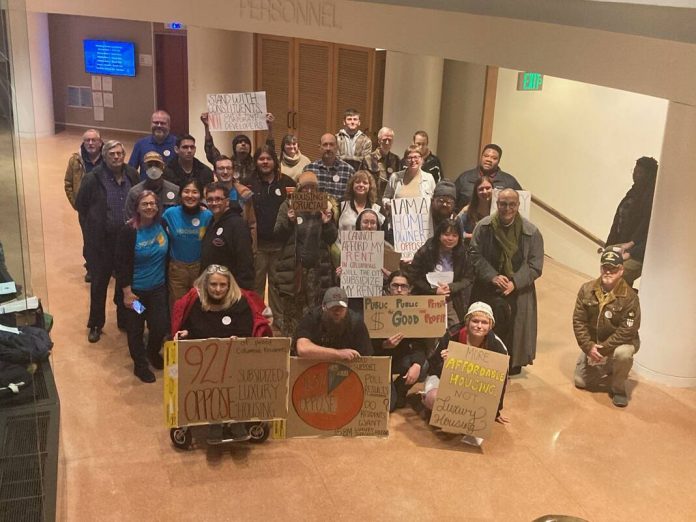
Photo by Jana Wiersema | The Republic Protestors are shown at Columbus City Hall reacting to a mixed-use apartment project planned for property near Cummins parking garage in downtown Columbus.
City officials have agreed to support a mixed-use development in front of the Cummins, Inc. parking garage with a $5.8 million subsidy.
Columbus City Council voted Tuesday to approve a project agreement, a resolution to create a new tax increment financing (TIF) district to help support the project, and the first reading of an ordinance authorizing a direct loan to the developer. Ordinances must pass on two readings to be fully approved, and the council’s next meeting is scheduled for Dec. 19.
All three votes were 4-2, with City Council members Jerone Wood and Grace Kestler voting against the measures. City Councilwoman Elaine Hilber abstained, as she is an employee of Cummins.
Tuesday’s council meeting saw a packed house, with about 80 individuals in the audience and 25 speaking during the time for public comment. Most of the speakers asked the council to vote no on the project or at least hold off on making a decision until the city completes its housing study.
At times, the meeting became heated, with some individuals stating that they feel city officials are prioritizing Cummins and higher-income individuals over the needs of working-class residents.
Flaherty & Collins, the developer of The Taylor, has presented a proposal to create a mix of apartment units and commercial space in front of Cummins’s parking garage, which is located along Washington Street between Sixth and Seventh streets.
“Cummins owns the property and have engaged Flaherty & Collins to develop the site into a mixed use development,” Redevelopment Director Heather Pope wrote in a memo to the council. “The proposal includes a five story structure with approximately 52 apartments (a mix of one and two bedrooms) and approximately 10,000 square feet of ground floor retail/commercial.”
Deron Kintner, general counsel with the developer, described the proposed apartments as market rate. The estimated cost of the project is $15.5 to $16 million, he said.
Under the terms of the project agreement, the city will use up to $5.8 million in funds from the Central TIF to cover a financing gap.
“The $5.8 million will be issued as a forgivable loan,” said Pope in a previous interview. “…We’ll just basically write a check for $5.8 million rather than taking on debt.”
She added that Flaherty & Collins will pay the amount back over time through their property taxes.
As part of this repayment strategy, the redevelopment department is working to create a new TIF at Sixth Street and Washington Street.
A TIF district is a mechanism that allows the redevelopment commission to retain increasing property taxes in a selected area to fund projects intended to benefit the community.
Now that the council has given its approval of the new TIF, the redevelopment commission will need to approve a declaratory resolution on the matter, Pope said. The commission’s next meeting is scheduled for Dec. 18.
Since the mixed-use proposal was unveiled, some city officials and members of the public have expressed concerns about the project, such as the possible price point of the apartments, the proposed level of subsidy, and whether or not the concept is the best use of the space.
On the other hand, those in support of the project have said that an influx of residents will benefit downtown, multiple housing types are needed in Columbus, and investing in this project does not preclude the commission from also pursuing affordable housing projects.
Ike Declue, executive director for the Office of Downtown Development, said that there is a need for more density and retail space downtown.
“It’s not a ‘this or that,’” said Al Roszczyk, president of the redevelopment commission. “We have the ability to fund or help fund workforce housing and other projects in Columbus.”
He added that the commission’s budget, from a TIF perspective, is several million dollars per year, and city officials are currently in discussions with developers for workforce housing and affordable housing.
However, Kestler expressed concern that more inexpensive housing may be located outside the “core or central areas of our community.”
She said the project presents a question of whether or not they want to create an “equitable” downtown and have areas where people with a mix of income levels can live.
Among those who showed up to protest the mixed use development were members of Hoosier Action, a community organization based in southern Indiana with members across the state and a Bartholomew County chapter. Its mission is to ensure that all Hoosiers “have a say in the decisions which affect their lives.”
The organization previously released an online survey with one question: “Do you support the city of Columbus giving $5.8 million dollars to a corporate developer to subsidize building a luxury apartment complex on 6th and Washington St.?”
The survey added that average rent would be $1,300 a month.
Kintner estimated at a previous meeting that he would expect the target price of the new apartments to be similar to the The Taylor, which is about “$1,300-something on average.” He said at Tuesday’s meeting that rent will ultimately be determined by the market.
According to Stephanie Zhang with Hoosier Action, 327 out of 355 respondents, or 92%, said that they did not support the subsidy. In the survey, 19 said that they did support it, and nine were not sure.
“I’m the target demographic,” said Jordan Bagwell during the time for public comment. “I’m an engineer at Cummins. I can tell you that … there are places for me to look and live. I’m not the one who y’all should be focused on. There are plenty of places where I could pay an extreme amount of money and live in this town, but there aren’t places where the people who are less fortunate can live a comfortable life. So that’s really it. We’re not the ones that you should be focused on.”




